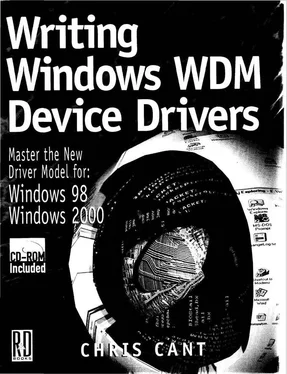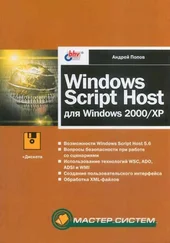Chris Cant - Writing Windows WDM Device Drivers
Здесь есть возможность читать онлайн «Chris Cant - Writing Windows WDM Device Drivers» весь текст электронной книги совершенно бесплатно (целиком полную версию без сокращений). В некоторых случаях можно слушать аудио, скачать через торрент в формате fb2 и присутствует краткое содержание. Город: Lawrence, Kansas 66046, ISBN: , Издательство: R & D Books, Жанр: Программирование, на английском языке. Описание произведения, (предисловие) а так же отзывы посетителей доступны на портале библиотеки ЛибКат.
- Название:Writing Windows WDM Device Drivers
- Автор:
- Издательство:R & D Books
- Жанр:
- Год:неизвестен
- Город:Lawrence, Kansas 66046
- ISBN:0-87930-565-7
- Рейтинг книги:5 / 5. Голосов: 1
-
Избранное:Добавить в избранное
- Отзывы:
-
Ваша оценка:
- 100
- 1
- 2
- 3
- 4
- 5
Writing Windows WDM Device Drivers: краткое содержание, описание и аннотация
Предлагаем к чтению аннотацию, описание, краткое содержание или предисловие (зависит от того, что написал сам автор книги «Writing Windows WDM Device Drivers»). Если вы не нашли необходимую информацию о книге — напишите в комментариях, мы постараемся отыскать её.
Writing Windows WDM Device Drivers — читать онлайн бесплатно полную книгу (весь текст) целиком
Ниже представлен текст книги, разбитый по страницам. Система сохранения места последней прочитанной страницы, позволяет с удобством читать онлайн бесплатно книгу «Writing Windows WDM Device Drivers», без необходимости каждый раз заново искать на чём Вы остановились. Поставьте закладку, и сможете в любой момент перейти на страницу, на которой закончили чтение.
Интервал:
Закладка:
The CallUSBDI routine in the UsbKbd driver is a candidate for this technique, as it is more than likely that the USB class drivers will take some time to process a USBDI request. However, it is usually the case that the USBDI call results are needed. Processing the results in a completion routine is just about possible. However, this will probably lead to code that is very complicated. In the end, it is probably simplest to leave the UsbKbd code as it is.
The DDK header files define several other HID IOCTLs. However, some of these are used by the HID class driver when it talks to a minidriver. It is not clear if any of these are available to HID clients.
Conclusion
This chapter concludes my look at the Human Input Device class driver. It is straightforward to write a user mode application to communicate with a HID device. A Win32 program looks for devices that use the HID device interface. They must then interrogate each device to see if their capabilities are of interest. The program can then read input reports and send output reports.
If need be, you can write a kernel mode HID client. It is best if you use the Plug and Play Notification technique to find any devices that support the HID device interface. Then, you can get the device capabilities and send and receive reports in a broadly similar way to user mode applications.
Both user mode and kernel mode HID clients can make use of the HID parsing routines. These make it much easier to find HID device's capabilities and to generate and understand reports.
Appendix A
Information Resources
Microsoft is the best source of information for most core Windows device driver development issues. Various books and newsgroups are also available to help driver writers. You may well need to check out other sources of information particular to your type of driver. You may need to seek help from vendors, standards bodies, and trade associations, as well as other driver writers.
A Microsoft Developer Network (MSDN) Professional Subscription provides most of the basic information you need to write device drivers. You get all the basic tools, Driver Development Kits (DDKs), and beta test versions of the Microsoft operating systems. However, it is worth keeping an eye on the Microsoft websites, as helpful articles and late-breaking news can often be posted. You will also need a C or C++ compiler, such as Visual Studio. The crucial Microsoft web sites are:
http://www.microsoft.com/hwdev/
http://www.microsoft.com/hwdev/driver/
http://msdn.microsoft.com/developer/
The DDKs include many example drivers that are very useful. Searching through these examples will often show you how to use a particular function or technique. Alternatively, you can base your entire driver on an existing example. Needless to say, do not use code blindly — make sure you understand what is going on. Finally, the sample driver directories often contain useful documentation in the form of Word or text files.
Table A.1 Information resources
| Advanced Configuration and Power Interface Specification, Revision 1.0 | http://www.teleport.com/~acpi/ |
| Device Bay Interface Specification, Version 1.0 | http://www.device-bay.org |
| Display Data Channel Standard, Version 3.0 | http://www.vesa.org |
| Extended Display Identification Data Standard, Version 2.0 | |
| El Torito — Bootable CD-ROM Format Specification, Version 1.0 | http://www.ptltd.com/techs/specs.html |
| Compaq, Intel, Phoenix BIOS Boot Specification, Version 1.01 | |
| Human Input Devices | http://www.usb.org/developers/ |
| IEEE 1394 Information | ftp://ftp.symbios.com/pub/standards/io/ |
| Intel hardware developer site | http://developer.intel.com |
| Interoperability Specification for ICCs and Personal Computer Systems | http://www.smartcardsys.com |
| Media Status Notification Support Specification, Version 1.03 | http://www.microsoft.com/hwdev/specs/ Vendor ID registration: pnpid@microsoft.com |
| Plug and Play specifications | |
| Multiprocessor Specification. Version 1.4 | Intel part number 242016-002 http://developer.intel.com |
| PC 99 System design guide | http://www.pcguide.com/ See the following books. PC 99a Addendum published in April 1999. |
| PCI Local Bus Specification, Revision 2.1 (PCI 2.1) | PCI Special Interest Group Phone: USA (800) 433-5177 http://www.pcisig.com |
| PCI Bus Power Management Interface Specification for PCI to CardBus Bridge, Revision 1.0 | |
| Plug and Play Specifications | |
| External COM Device Specification, Version 1.0 | http://www.microsoft.com/hwdev/specs/ |
| Industry Standard Architecture (ISA) Specification, Version 1.0a | |
| Clarification to Plug and Play ISA Specification, Version 1.0a | |
| Parallel Port Device Specification, Version 1.0b | |
| Small Computer System Interface Specification, Version 1.0 | |
| Power Management specifications for device and bus classes | http://www.microsoft.com/hwdev/onnow.htm |
| Guidelines for audible noise and other OnNow technologies | |
| SFF 8070i, SFF 8038i, SFF 8090 (Mt. Fuji specification), and other SFF specifications | SFF Committee publications FaxAccess: USA (408) 741-1600 (fax-back) Fax: USA (408) 867-2115 ftp://ftp.symbios.com/pub/standards/io/ |
| SysInternals web site for device driver utilities and information | http://www.sysinternals.com/ |
| Smart Battery System Specification | http://www.sbs-forum.org/ |
| Smart Battery Charger Specification, Version 1.0 | |
| Smart Battery Selector Specification, Version 1.0 | |
| USB Specification, Version 1.0 | Phone: USA (503) 264-0590 Fax: USA (503) 693-7975 http://www.usb.org/developers/ |
| USB Class Definition for Communications Devices, Version 0.9 | |
| USB Common Class Specification, Version 0.9 | |
| USB Device Class Definition for Audio Devices, Version 0.9 | |
| USB Device Class Definition for Human Interface Devices, Version 1.0 | |
| USB Device Class Definition for Mass Storage Devices, Version 0.9 | |
| USB Device Class Definition for Printing Devices, Version 1.0 | |
| USB HID Usages Tables, Version 0.9 | |
| USB Monitor Control Class Specification, Version 1.0 | |
| USB Power Devices Usages Table, Version 0.9 | |
| Web-Based Enterprise Management (WBEM) | http://www.microsoft.com/management/wbem/ http://www.dmtf.org/ |
| Windows 98 and Windows 2000 DDKs, including NDIS documentation | MSDN Professional membership http://msdn.microsoft.com/ |
| Windows Hardware Instrumentation Implementation Guidelines, Version 1.0 (WHIIG), Microsoft Corporation and Intel Corporation | http://www.microsoft.com/hwdev/specs |
| Wired for Management Baseline Specification, Version 2.0, Intel Corporation. | http://developer.intel.com/ial/WfM/index.htm |
Newsgroups and Mail Lists
The two primary Newsgroups for DDK information are comp.os.ms-windows.programmer.nt.kernel-mode and comp.os.ms-windows.programmer.vxd. The Microsoft news server at msnews.microsoft.com also has some useful newsgroups.
The ntdev mailing list covers all NT and W2000 development issues, including device drivers. Subscribe by sending an e-mail to majordomo@atria.com with the following in the body of the message, "subscribe ntdev your_email_address". A daily digest of this list can be obtained by subscribing to the ntdev-digest mailing list instead.
Читать дальшеИнтервал:
Закладка:
Похожие книги на «Writing Windows WDM Device Drivers»
Представляем Вашему вниманию похожие книги на «Writing Windows WDM Device Drivers» списком для выбора. Мы отобрали схожую по названию и смыслу литературу в надежде предоставить читателям больше вариантов отыскать новые, интересные, ещё непрочитанные произведения.
Обсуждение, отзывы о книге «Writing Windows WDM Device Drivers» и просто собственные мнения читателей. Оставьте ваши комментарии, напишите, что Вы думаете о произведении, его смысле или главных героях. Укажите что конкретно понравилось, а что нет, и почему Вы так считаете.






